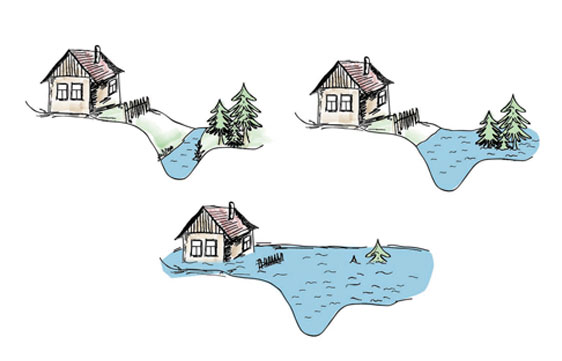
Significant provincial changes to environmental policy are forcing local conservation authorities to cut budgets and trim programs
FOR MORE THAN 70 YEARS ONTARIO’S CONSERVATION AUTHORITIES have taken a watershed-wide approach to flood control, conservation and land management, a model which bypasses political boundaries to recognize the natural links between forests, wetlands and river systems and their interplay with human activities.
It’s an approach that helped protect Ontarians from the worst consequences of devastating flooding, which the province experienced this spring, and protected our water sources and local aquifers. This approach also allowed conservation authorities to maintain animal habitat, provide opportunities for outdoor recreation and education within the green spaces they protected.
Now, the provincial government wants to change that approach, as it cuts flood management funding by half and revises the Conservation Authorities Act, to the possible detriment of watershed-wide conservation programs.
The Ganaraska Region Conservation Authority (GRCA) encompasses the watersheds of the Ganaraska River and Wilmot Creek, along with a number of other smaller creeks and streams. At GRCA, CAO/Secretary-Treasurer Linda Laliberte has had to contend with a mid-budget year cut of nearly $50,000 for flood management, along with the cancellation of three summer student positions under the Summer Experience Program. As a result, the authority has had to eliminate a staff position at the Ganaraska Forest Centre.
Further east, the Quinte Conservation Authority has faced a bigger cut, losing half of the nearly $322,000 it has received annually over the past two decades, while the Lower Trent Conservation Authority is absorbing a cut of nearly $65,000.
“This cut has left a large financial gap in Quinte Conservation’s budget as well as a gap in the critical services that help protect public health and safety from the impacts of flooding,” says Quinte Conservation Authority CAO, Brad McNevin.
While the flood management funding cuts are being felt immediately, the bigger long-term impact to conservation authority activities may come from changes to the Conservation Authorities Act under Bill 108, The More Homes, More Choice Act.
HISTORICALLY, CONSERVATION AUTHORITY decisions have been made collectively by a board representing each municipality within the watershed. These municipalities pay a levy to support authority activities on a watershed-wide basis.
Bill 108 makes a couple of significant changes to the old model. Firstly, it restricts the list of mandatory programs provided by conservation authorities to just four areas – flooding and natural hazards, watershed management on conservation authority-owned lands, drinking water source protection, and the Lake Simcoe Protection Plan, which is irrelevant to our local authorities. The second impact is that any non-mandatory programs offered by a conservation authority are to be negotiated on an individual basis with member municipalities, not collectively.
At the GRCA, non-mandated programs include watershed monitoring, outdoor education and some stewardship activities. Linda Laliberte predicts negotiating these non-mandated programs with individual municipalities is “going to prove to be a very onerous process creating much more red tape and duplication of effort for both CAs and municipalities.”
“Then, if some municipalities opt out, the programs and services aren’t covering the entire watershed – thereby creating a patchwork of programs and services with only some actually providing watershed- wide benefits.”
Linda Laliberte says the problem with the province’s list of mandatory programs is that “it doesn’t really support or protect the overall watershed management role of conservation authorities.”
Conservation Ontario, the organization that represents conservation authorities has asked the province for a fifth priority area – conserving natural resources – in an effort to counter the impacts of the province’s changes.
It remains to be seen whether the province responds to Conservation Ontario’s request. Although the changes to the Conservation Authority Act have passed, the province has left a door open for modifications, albeit for a limited period. Linda Laliberte explains the province did not specifically include “conserving natural resources, however they did include a new category of mandatory programs and services that the Lieutenant Governor in Council could prescribe within one year of the other man – datory programs and services being enacted.”
The funding cuts and changes to the Conservation Authorities Act come as Ontario’s government draws fire from environmentalists for other actions, including changes to the province’s Endangered Species Act (ESA), also under Bill 108.
WHEN IT WAS PASSED INTO LAW BY THE McGuinty Liberals in 2007, Ontario’s ESA was hailed as a gold standard in environmental legislation, tripling the number of species under protection while protecting their habitat. But recent changes to the ESA under the provincial government include an option for developers to pay charges that could allow them to carry out activities prohibited under the Act, if those developers meet certain conditions. Critics call the change ‘pay to slay.’ Another controversial change to the ESA would consider the conservation status of a species outside Ontario while determining whether they should be protected here. In such a scenario a species such as the Eastern hognose snake, considered threatened in Ontario, could lose protection because its status is ‘least concern’ in the Eastern United States.
Ontario Nature, which represents more than 150 member groups including the local Willow Beach Field Naturalists, has condemned the changes. “The amendments give new powers to the Minister to delay, limit and remove protections for at-risk species. Further, it creates numerous, overlapping pathways for developers and industrialists to dodge critical requirements. Those with a vested, short-term economic interest in sprawl development now have free rein to bulldoze, dig up and pave over the habitats of our most vulnerable plants and animals.”
Northumberland-Peterborough South MPP David Piccini defended the More Homes, More Choice Act, saying its intent is to address Ontario’s housing crisis, “helping to build more affordable homes in our province by cutting red tape, making costs for home owners more predictable, and making it easier to build different types of housing.”
Commenting on changes to the Conservation Authorities Act, he said his government is focused on “helping Conservation Authorities deliver on their core mandate so that they can continue to play a frontline role in Ontario’s land planning and environmental protection process.”
According to Piccini the changes will streamline the role conservation authorities play in municipal planning, make approvals faster and less costly, and improve conservation authority governance, oversight and accountability.
What the future holds for environmental protection and conservation in Ontario is unclear.
What seems certain is that, until the next election, Ontarians with specific environmental concerns will become vocal and active if they wish to protect threatened landscapes and species. Premier Doug Ford’s suggestion in early summer of last year that he would open up areas of Ontario’s Greenbelt to development met with a wave of public opposition that resulted in his changing course. And the outcry resulting from the provincial government’s decision to cancel funds for Forest Ontario’s 50 Million Tree program prompted the federal government to step in and provide support. Environmentalists wanting to reverse other decisions will need to take heed, dig in and get organized.
Story by:
Norm Wagenaar




